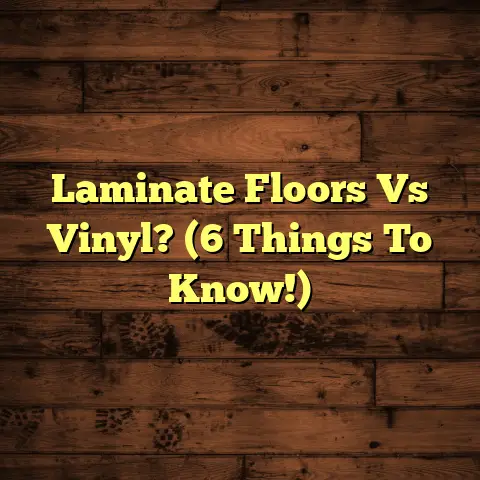Types of Wooden Flooring (8 Wood Floor Options!)
I’m excited to share my expertise with you.
Choosing the right wood floor can feel like a major decision, right?
I get it. I’ve been in the flooring game for years, and I’ve seen it all.
From helping folks pick the perfect hardwood for their dream homes to troubleshooting warped floors after a rogue plumbing incident, I’ve learned a thing or two.
Let’s dive into the wonderful world of wooden flooring.
We’ll explore eight fantastic options that can transform your space.
Get ready to discover the ideal fit for your style, budget, and lifestyle.
Understanding Wooden Flooring
What is Wooden Flooring?
Wooden flooring, at its core, is any flooring made primarily from wood.
Its history is rich, dating back centuries when solid planks were the only option.
Think about those grand old castles with their wide-plank oak floors.
Over time, technology has evolved, giving us engineered options.
Also, alternative wood-like materials like laminate have become popular.
This evolution has made wood flooring more accessible and versatile.
The Appeal of Wood Flooring
Why choose wood? Well, where do I even begin?
Aesthetically, wood brings a warmth and elegance that’s hard to replicate.
Each plank has its own unique grain pattern and color variation.
This creates a natural, organic feel that can elevate any room.
It feels great underfoot.
It offers a slight give that’s much more comfortable than tile or concrete.
Environmentally, wood can be a sustainable choice.
Especially when sourced responsibly from well-managed forests.
Plus, a well-maintained wood floor can last for decades.
This makes it a long-term investment that adds value to your home.
Types of Wooden Flooring
1. Solid Hardwood Flooring
Definition and Characteristics
Solid hardwood is exactly what it sounds like: planks milled from a single piece of wood.
These are typically ¾ inch thick, and come in various widths.
I’ve seen planks as narrow as 2 ¼ inches and as wide as 12 inches.
The beauty of solid hardwood lies in its authenticity and longevity.
Common Species Used
Oak is king (or queen) in the hardwood world.
It’s durable, readily available, and takes stain beautifully.
Maple is another popular choice, known for its light color and smooth grain.
Cherry offers a richer, warmer tone, and walnut brings a touch of luxury.
I’ve even worked with exotic species like Brazilian cherry (jatoba) for a truly unique look.
Advantages and Disadvantages
Advantages:
- Timeless beauty and adds value to your home.
- Can be refinished multiple times, extending its lifespan.
- Solid feel underfoot.
Disadvantages:
- Susceptible to moisture damage and expansion/contraction.
- More expensive than other options.
- Requires professional installation for best results.
Best Environments for Solid Hardwood
Solid hardwood thrives in stable environments with consistent humidity levels.
Living rooms, dining rooms, and bedrooms are ideal.
I generally advise against installing it in basements or bathrooms.
The high moisture content can cause warping and damage.
2. Engineered Hardwood Flooring
Explanation of Engineered Wood and its Structure
Engineered hardwood consists of multiple layers of wood.
These are bonded together with a top layer of real hardwood veneer.
This construction makes it more stable and less prone to warping than solid hardwood.
Comparison with Solid Hardwood
Durability: Engineered hardwood is more resistant to moisture and temperature changes.
Cost: Generally less expensive than solid hardwood.
Installation: Easier to install, often available in click-lock systems.
I’ve seen DIYers successfully install engineered floors with minimal experience.
Ideal Uses and Environments
Engineered hardwood is a versatile option that can be used in many areas.
It’s a great choice for basements, kitchens, and other areas.
These areas are with moderate moisture levels.
I’ve even seen it used in some bathrooms with proper ventilation.
3. Bamboo Flooring
Overview of Bamboo as a Sustainable Flooring Option
Bamboo is technically a grass, but it’s incredibly strong and fast-growing.
This makes it a highly renewable and sustainable flooring option.
I’m a big fan of bamboo for its eco-friendly qualities.
Types of Bamboo Flooring
- Strand-woven: The most durable type, made by compressing bamboo strands.
- Horizontal: Shows the characteristic bamboo “knuckles.”
- Vertical: Presents a more linear grain pattern.
Pros and Cons
Pros:
- Sustainable and eco-friendly.
- Durable (especially strand-woven).
- Unique and stylish look.
Cons:
- Can be susceptible to scratches and dents.
- Quality varies widely depending on the manufacturer.
- Some types may off-gas VOCs (volatile organic compounds).
4. Laminate Flooring with Wood Finish
Explanation of Laminate Flooring and its Construction
Laminate flooring is a synthetic product made of multiple layers.
It is fused together under high pressure.
The top layer is a photographic image of wood.
This is protected by a clear wear layer.
Benefits of a Wood Finish and its Visual Appeal
Laminate offers the look of wood at a fraction of the cost.
Advances in technology have made laminate increasingly realistic.
I’ve seen some that are almost indistinguishable from real wood.
Situations where Laminate is a Practical Choice
Laminate is a great option for high-traffic areas, homes with pets, and budget-conscious homeowners.
It’s easy to clean, scratch-resistant, and relatively simple to install.
I often recommend it for rental properties or basements where moisture is a concern.
5. Reclaimed Wood Flooring
Discussion of Reclaimed Wood and its Benefits
Reclaimed wood is salvaged from old buildings, barns, and factories.
It brings a unique history and character to any space.
I love the story behind each plank and the sustainable aspect of reusing materials.
Unique Aspects of Reclaimed Wood
- History: Each plank tells a story of its past life.
- Character: Filled with nail holes, knots, and imperfections.
- Sustainability: Reduces the demand for new lumber.
Suitable Applications and Design Trends
Reclaimed wood is perfect for creating a rustic, vintage, or industrial look.
It’s often used in accent walls, feature floors, and even furniture.
I’ve seen it paired with modern elements for a stunning contrast.
6. Cork Flooring
Overview of Cork as a Flooring Material and its Properties
Cork is harvested from the bark of cork oak trees.
The bark grows back, making it a renewable resource.
It’s naturally soft, warm, and sound-absorbent.
Benefits of Cork Flooring
- Insulation: Provides excellent thermal and acoustic insulation.
- Comfort: Soft and comfortable underfoot.
- Sustainability: Renewable and eco-friendly.
Best Uses for Cork Flooring
Cork is a great choice for bedrooms, playrooms, and home offices.
It’s also ideal for anyone with allergies.
This is because it’s naturally resistant to mold and mildew.
7. Plywood Flooring
Explanation of Plywood Flooring and its Layers
Plywood flooring consists of multiple layers of wood veneer.
These are glued together with the grain running in alternating directions.
This construction makes it strong and stable.
Advantages and Disadvantages
Advantages:
- Affordable.
- Stable and durable.
- Can be stained or painted.
Disadvantages:
- Not as aesthetically pleasing as other wood options.
- Requires a sealant to protect against moisture.
Recommended Applications and Installation Techniques
Plywood is often used as a subfloor.
However, it can also be used as a finished floor in utility areas.
Also, it is suitable for workshops, or garages.
I recommend using a high-quality sealant and applying multiple coats for durability.
8. Parquet Flooring
Definition and Design Aesthetics of Parquet Flooring
Parquet flooring consists of small pieces of wood arranged in geometric patterns.
Think squares, triangles, and diamonds.
It adds a touch of elegance and sophistication to any room.
Historical Significance and Modern Applications
Parquet flooring has a long history.
It dates back to the 17th century.
It was commonly found in grand European castles and palaces.
Today, it’s experiencing a resurgence in popularity.
Maintenance Tips and Style Considerations
Parquet flooring requires regular cleaning and waxing to maintain its luster.
Choose patterns and wood species that complement your overall design aesthetic.
I’ve seen it used in both traditional and contemporary settings.
Choosing the Right Wood Flooring for Your Space
Factors to Consider When Selecting Wood Flooring
- Foot traffic: High-traffic areas require durable options.
- Climate: Consider humidity levels and temperature fluctuations.
- Personal style: Choose a wood species, color, and pattern.
- Budget: Prices vary widely depending on the type of wood.
Design Trends in Wooden Flooring
- Wide planks: Creates a more modern and spacious feel.
- Gray tones: Popular for a contemporary and sophisticated look.
- Matte finishes: Hides scratches and imperfections.
- Herringbone patterns: Adds a touch of elegance and visual interest.
Installation and Maintenance of Wooden Flooring
Installation Methods
- Nail-down: Best for solid hardwood.
- Glue-down: Suitable for engineered hardwood and parquet.
- Floating: Common for engineered hardwood and laminate.
Maintenance Tips
- Sweep or vacuum regularly to remove dirt and debris.
- Use a damp mop with a wood-floor cleaner.
- Avoid excessive water and harsh chemicals.
- Apply a protective coating or wax as needed.
The Allure of Wooden Flooring
Recap of Options
We’ve covered a lot of ground.
From solid hardwood to engineered options, and even bamboo and laminate.
Each type of wood flooring offers unique benefits and aesthetic qualities.
Final Thoughts
Choosing the right flooring is a big decision.
It should reflect your personal style and enhance your living space.
Consider your lifestyle, budget, and environmental concerns when making your choice.
With the right wood floor, you can create a warm, inviting space that you’ll love for years to come.
I hope this guide has been helpful.
Remember, I’m always here to answer any questions you may have.
Happy flooring!





